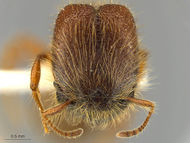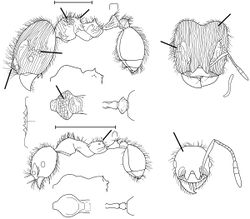Key to Pheidole scrobifera group
This worker key is based on: Wilson, E. O. 2003. Pheidole in the New World: A dominant, hyperdiverse ant genus. Harvard University Press, Cambridge, MA. and as modified by: LaPolla, J. S. and Cover, S. P. 2005. New species of Pheidole (Hymenoptera : Formicidae) from Guyana, with a list of species known from the country. Trans. Am. Entomol. Soc. 131(3-4):365-374.
Big (in most cases), hairy, scrobe-headed, and heavily sculptured: such is a serviceable capsule description of the scrobifera-group major caste. The center of species diversity is tropical Mexico and Central America, with one representative each known from Cuba and Ecuador. The origin of the group is problematic, but a fair guess at this time, based on the general body form of the minor caste, is that the scrobifera group arose from somewhere within the large Neotropical tristis group or from a common ancestor. The species Pheidole epetrion is known from minors only, and should be checked directly from the drawings. When majors are available, epetrion is likely to key out to Pheidole simonsi.
You may also be interested in
1
- Major: in full-face view almost all of the dorsal surface of the head covered by a single carinulate shield that includes the frontal lobes; the frontal lobes in full -face view expanded laterally to touch the eyes and anteriorly to cover most of the lateral wings of the clypeus; head completely covered by extremely long hairs, some of which are more than half as long as the antennal scape (southern Mexico, Guatemala) . . . . . Pheidole tisiphone (known only from the major)
 Pheidole tisiphone, Major |
- Major: in full -face view, the frontal lobes neither reach the eyes nor cover the lateral wings of the clypeus; hairs on head much shorter than half the length of the antennal scape . . . . . 2
2
return to couplet #1
- Major: in full-face view, posterior margin (=occiput) free of rugoreticulae, in contrast with rest of head capsule, which (exclusive of center of the clypeus) is entirely rugoreticulate . . . . . 2a
- Major: posterior margin (= occiput) in full-face view rugoreticulate or longitudinally carinulate . . . . . 3
2a
return to couplet #2
- Major: in lateral view, most of dorsal profile of the head, from the anterior clypeal margin(= clypeal border) to the level of the posterior margin of the antennal scrobe, bears a dense row of very short, perfectly erect hairs, all approximately equal in length like the teeth of a comb . . . . . Pheidole peckorum
- Major: in lateral view, most of dorsal profile of the head, from the anterior clypeal margin(= clypeal border) to the level of the posterior margin of the antennal scrobe, bears erect hairs that become gradually longer toward posterior margin . . . . . Pheidole funki
3
return to couplet #2
- Major: in full -face view, occiput covered by parallel longitudinal carinulae (Amazonian Brazil and Peru) . . . . . Pheidole mamore
- Major: in full -face view, occiput covered by rugoreticulum . . . . . 4
4
return to couplet #3
- Major: entire dorsum of promesonotum rugoreticulate; profile of head, in side view, strongly "dented"-with a deep concavity, just anterior to the occiput. Minor: entire dorsum of promesonotum rugoreticulate (Honduras) . . . . . Pheidole wardi
- Major: at most, only the humeri are rugoreticulate; profile of head just anterior to occiput convex, or straight, or at most very feebly concave. Minor: pronotum smooth and shiny, transversely carinulate . . . . . 5
5
return to couplet #4
- Major: pronotal dorsum lacking carinulae or rugoreticulum (Costa Rica) . . . . . 6
- Major: pronotal dorsum mostly covered with carinulae, with or without some rugoreticulum . . . . . 7
6
return to couplet #5
- Major: frontal lobes and pronotal dorsum entirely smooth and shiny; in side view, profile of head and mesosoma fringed by dense layer of erect to sub erect hairs as long as the eye or longer. Minor: pronotum and dorsal surface of head smooth and shiny; occiput with posterior nuchal collar (Costa Rica) . . . . . Pheidole vestita
 Pheidole vestita, Major |
- Major: frontal lobes covered by parallel longitudinal carinulae; pronotal dorsum foveolate and opaque; in side view, profile of head and mesosoma fringed by erect to subrecumbent hairs mostly less than half the length of the eye. Minor: pronotum and dorsal surface of head foveolate and opaque; nuchal collar absent (Costa Rica) . . . . . Pheidole scrobifera
 Pheidole scrobifera, Major |
7
return to couplet #5
- Major: in full-face view, entire dorsum of head capsule, including central third, covered by carinulae or rugoreticulum. Minor: head and pronotum completely foveolate and opaque; pronotal dorsum is transversely carinulate; scape exceeds occipital corner by at least 5X its own maximum width (Cuba) . . . . . Pheidole cubaensis
 Pheidole cubaensis, Major |
- Major: in full-face view, central third of head capsule devoid of carinulae and rugoreticulum, covered with foveolae only. Minor: head and pronotum entirely smooth and shiny; scape exceeds occipital corner by much less than 5 X its own length . . . . . 8
8
return to couplet #7
- Major: most of space between eye and anterior half of frontal lobe rugoreticulate; in full-face view, rugoreticulum at margins of head extends from occiput anteriorly all the way to the antennal scrobes (Tamaulipas, Mexico) (The species epetrion is known only from the minors and is likely to key out here also; check the drawings and diagnoses) . . . . . Pheidole simonsi
- Major: space between eye and anterior half of lobe lacks rugoreticulum; in full-face view, rugoreticulum at margins of head fails to extend anteriorly all the way to the antennal scrobes . . . . . 9
9
return to couplet #8
- Major: rugoreticulum present mesad to posterior fifth of antennal scrobe; anterior edge of central third of first gastral tergite longitudinally striate; postpetiolar dorsum with at most several feeble longitudinal carinulae (Veracruz, Mexico) . . . . . Pheidole simonsi
- Major: no rugoreticulum present mesad to posterior fifth of antennal scrobe; anterior edge of central third of first gastral tergite foveolate but not striate; postpetiolar dorsum rugoreticulate (Costa Rica) . . . . . Pheidole simonsi
 Pheidole simonsi, Minor |
















